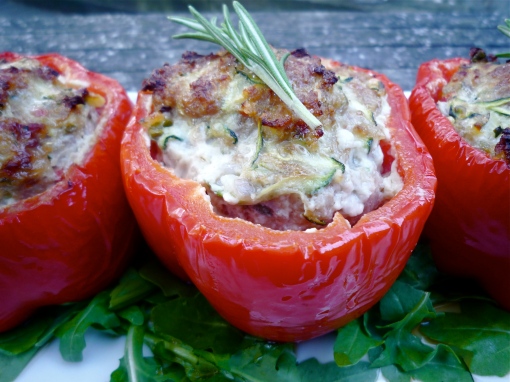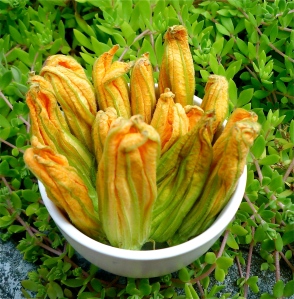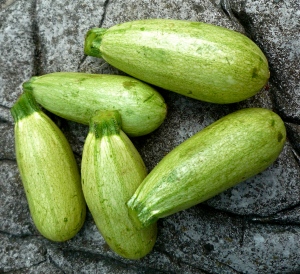It may be September but don’t be fooled by the calendar – it’s still summer and many areas continue to be hot and humid! A refreshing Vietnamese-inspired noodle dish with crisp vegetables, fresh herbs and spicy pork is the perfect dish to cool down with.
A Note About Ingredients
When I first started this site, just over three years ago, my goal was to present recipes with ingredients that were accessible to most people in North America, whether they lived in large cities or rural areas (like most of my family does). At the time, that meant that anything remotely exotic had to be excluded. However, over the past couple of years, even grocery stores in small towns now carry ingredients from around the world (well, not every small town, but the situation is improving in most places!). The ingredients for this recipe should be readily available anywhere with the possible exception of fish sauce (nuoc mam), rice vermicelli (banh pho) and oyster sauce. Any city with a large Asian population will have markets where you can buy these items; in smaller centers check the rice isle and condiment section (some stores also place imported items under ‘Ethnic Foods’). A Taste of Thai and Thai Kitchen brands are often carried in large supermarket chains. For substitutions, check out the Cook’s Thesaurus: Asian Condiments.

Some Vietnamese and Thai pantry basics: (from left) Thai fish sauce, rice vermicelli (banh pho), Three Crabs brand fish sauce, Thai rice stick noodles, oyster sauce.
Note: This recipe should be suitable for gluten-free diets, however, check the label of the fish sauce and oyster sauce to ensure that no gluten was used in their preparation.
Vietnamese-Style Rice Noodles with Spicy Pork
Makes 4 to 6 servings
This recipe is a little long and requires a bit of prep work but it’s very simple if you take it step-by-step. You will need about three limes total for the juice and garnish. Be sure to use fresh herbs to garnish – they will make the dish come together.
Dressing:
- 3 Tablespoons fresh lime juice
- 1-1/2 Tablespoons fish sauce (preferably Three Crabs brand but any kind will do)
- 3 Tablespoons vegetable oil (canola or safflower work well)
- 1-1/2 Tablespoons sugar
- 2 large cloves garlic, very finely minced
- 3 Tablespoons very finely minced shallot
- 1 teaspoon red pepper flakes
- Pinch of salt
- In a small bowl or measuring cup, add all ingredients and whisk until combined. Set aside until ready to use.
Spiced Pork:
- 2 teaspoons vegetable oil
- 450 g / 1 lb. lean ground pork
- 2 cloves garlic, very finely minced
- 1 medium shallot, minced
- 3 Thai bird chiles, finely minced or 1-1/2 teaspoons red pepper flakes (or to taste)
- 3 X 1” pieces lemongrass (eliminate if you can’t find it)
- 1 Tablespoon fresh lime juice
- 1 Tablespoon oyster sauce
- 1 Tablespoon fish sauce
- 2 teaspoons brown sugar
- 1 teaspoon coarsely ground black pepper
- Salt, to taste
- In large skillet, heat the vegetable oil on medium-high heat. Add the ground pork and use a spatula to break it up. Cook for one minute.
- Add the garlic, shallot, chiles and lemongrass pieces. Stir into the pork until thoroughly combined. Cook the mixture until the pork is just past pink, about 5 to 7 minutes.
- Add the lime juice, oyster sauce, fish sauce, brown sugar and pepper. Stir to combine. Reduce the heat to medium and let simmer for another two minutes. Remove the lemongrass pieces and discard.
- Season the pork mixture with salt and set the mixture aside until ready to use.
Noodles and Vegetables:
- 12 oz. / 340 grams dry rice vermicelli noodles (banh pho – about 3 mm wide – if these aren’t available any kind of flat rice noodle will work)
- 1 medium English cucumber
- 1 medium carrot
- 1 medium red pepper
- 1 cup bean sprouts or ½ cup shredded lettuce
- To prepare the noodles: Bring a pot of water to a boil. Drop in the dry noodles and cook for about 3 minutes or until just tender. Drain and rinse with cold water to halt the cooking. Place in a bowl and set aside until ready to use.
- To prepare the vegetables: Slice the cucumber into rounds, about 1/8“ thick. Discard the ends.
- Peel the carrots and cut into thin matchsticks and cut the red pepper into thin strips.
Garnishes:
- Fresh cilantro
- Fresh mint
- ¼ cup dry roasted peanuts, chopped
- Fried shallot rings (see below)
- 1 lime, cut into 6 wedges
Fried Shallot Rings:
- 1 medium shallot
- Vegetable oil – enough to cover the bottom of a small saucepan about ½” deep
- Pinch of salt
- Peel the shallot and slice into thin rings. Heat the oil in a small saucepan on high. Add the shallot rings and fry until golden and crispy, about 3 to 4 minutes. Make sure you don’t overcook them or they will become bitter.
- Use a slotted spoon to remove the rings from the oil and set them aside on a piece of paper towel. Sprinkle with a pinch of salt and set aside until ready to use.
Putting it All Together:
- Place the softened noodles in a large bowl. Add the sliced cucumber, carrot and pepper strips and bean sprouts.
- Pour in the dressing and toss until everything is coated and thoroughly combined.
- Plate the noodles and top with the spiced pork. Garnish with torn fresh coriander and mint, chopped peanuts and fried shallot rings. Serve with lime wedges on the side to squeeze over the dish when served.
- The dish can be served warm or at room temperature.



















